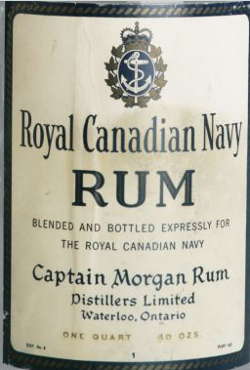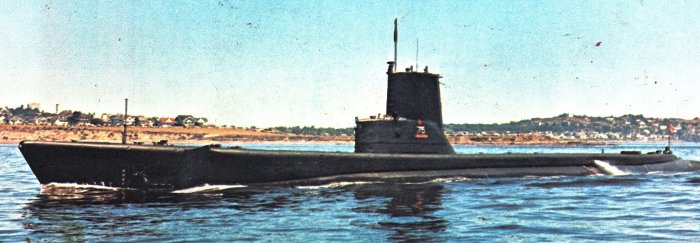Topic: RCN

The RCN Rum Ration; Reviewed, Retained, Ended

The Montreal Gazette;
14 December, 1939
Rum Ration Retained
Ottawa, December 13. — CP — Men of the Royal Canadian Navy, and other branches of Canada's Active Service Forces may well say "Heave ho, my hearties" today for that ration of rum is to be continued. After examination by Government experts a proposal to substitute brandy for the traditional rum ration has been squelched.
The Maple Leaf;
17 February, 1945
Where Does It Go?
Ottawa — (CP) — An increasing number of Canada's seamen are passing up their daily rum ration in lieu of the alternative five cents, Navy Minister Macdonald disclosed. He said he believed the figures stood at about 60 per cent temperate, 40 per cent "grogs." The men are given the opportunity to change their minds on the subject every four months.
The News and Courier;
15 May 1955
Canadian Navy's Rum Ration Hit
Winnipeg, Man., May 14 — (AP) — The daily ration of rum for members of the Canadian navy should be discontinued, the Manitoba Temperance Alliance said in a resolution adopted at its annual meeting.
1949
The Montreal Gazette; 2 November, 1949
Canadian Navy Advised to Review Age-old Custom of Rum Rations
Ottawa, Nov. 1 — (CP) — Naval authorities were asked today to review the question of serving alcoholic beverages aboard ships of the RCN and to make a report on the matter to Defence Minister Claxton.
The request came in the report of the commission which investigated incidents aboard the aircraft carrier Magnificent and the destroyers Athabaskan and Crescent last February and March.
The commission itself expressed no opinion on the system of wardroom privileges for officers and a daily tot of rum issued to ratings or, in lieu, a cash payment.
"We believe that if any change is to take place, it should not be imposed by an outside authority but should be the result of a careful assessment of all factors by the Navy itself,: the report said.
During its sittings, the commission heard a number of proposals, including abolition of alcoholic drinks on board Canadian ships, adoption of the American system whereby beer is issued to the men and officers are allowed to buy drinks at shore prices; and abolition of all drinks while the ship is at sea.
The first of these proposals would introduce the United States Navy system into the RCN—a strict ban on alcohol for both officers and men.
The report noted that the Canadian system at present was inherited from the British navy from "age-old customs" and that during tropical cruises the custom of making and issue of beer to the men has been followed occasionally.
"It is generally argued by advocates of the present system," the report said, "that it has long been accepted by and acceptable to all ranks; that it has not been abused' that it is a fair reflection at sea of the privileges of men on shore and that it helps to strengthen the self-discipline of officers and men.
"The American system, on the other hand, is alleged to contribute to law-breaking at sea and to over-indulgence on shore.
"On the other hand, evidence was offered that the differential privileges of officers and men occasionally but infrequently are met with a measure of dissatisfaction on the lower decks and that the issue of alcohol was responsible for many of the disciplinarily troubles on board ship…"
1972
The Montreal Gazette; 31 Mar 1972
Main brace spliced for the last time
Halifax — (CP) — No more will sailors in the Canadian navy get their daily rum tot. The issue of 2 ½ ounces of dark rum was given yesterday for the last time, ending a naval tradition that dates back to 1667.
"Splice the main brace" is a naval order usually reserved for an extremely special occasion like a victory at sea of a duty well performed.
It brings about a double rum ration to all sailors of the fleet.
Rear-Admiral R.W. Timbrell commander Maritime Command, gave the order to "splice the main brace" yesterday and the traditional ceremony went out in style.
With all hands mustered to the afterdeck of the destroyer Kootenay, the tots of dark rum were drawn for the last time.
Tradition
When everyone had the traditional rum issue from the regulation oak tub that Cmdr Jim Creech obtained for the occasion, he spoke briefly of the tradition which is being eliminated in favour of facilities for wine, spirits and beer on the vessels.
From the oaken keg bearing the burnished brass inscription, "The Queen, God bless her," the hands got their second tot and then drank to the Queen's health.
Then Cmdr Creech pulled the final tot from the tub and, with the naval band providing the music, poured it over the side.
Last December former defence minister Donald Macdonald announced that the Canadian navy would follow similar steps by the Royal Navy and end the rum ration.
The tradition of a daily issue of one part of overproof rum to two parts water — though latterly a cola was used — has been followed by the British navy for three centuries and the Canadian navy wince it came into being in 1910.
It became known by a variety of names including "Nelson's blood."
When British Admiral Lord Vernon, known as "old Grog" because of a coat he wore, ordered the rum cut with two parts of water, it became known as grog.
But the name "Nelson's blood" was somewhat more colorful. The term is believed to have roots in the historic fact that after Admiral Nelson was killed at Trafalgar, his body was shipped home preserved in a barrel of spirits.
When the barrel arrived in England, Nelson was in it, but the spirits, it is said, were not.
The spirits might have leaked out, but there is supporting evidence that sailors took the opportunity to tipple on the sly.
The Royal Navy upheld the tradition of "tapping the admiral" until last summer when it announced that more popular alcoholic beverages would replace the rum. Canada decided to follow the same line. The rum was issued just before the noon meal aboard navy ships and cost the government $363,000 a year including sales and excise taxes.

HMCS Rainbow
The Saturday Citizen, 1 April, 1972
Sailors take final swig of daily rum
Victoria (CP) — Servicemen dressed in period naval costumes and carrying dummy coffin containing six bottles of rum, paraded somberly through the dockyard Thursday at the Canadian Forces base in nearby Esquimalt.
The brief ceremony marked the death of the daily rum ration for the Canadian forces.
As the coffin carriers, members of the submarine HMCS Rainbow, completed their procession, Rear-Admiral Richard Leir, commander, Pacific Maritime Forces, called a "splice the main brace."
This allowed all the sailors aboard ships in the harbor to hoist their final tot of rum.
The daily tot of rum is a naval tradition dating back to the 1600s. Last year the British government decided to discontinue the practice for the Royal Navy and the Canadian navy followed suit.

